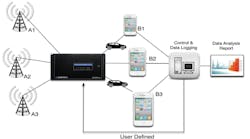Being equally flexible and reconfigurable, RF matrix switches could help to simplify the RF test configurations needed to test heterogeneous networks (HetNets), distributed antenna systems (DASs), and wireless sensor networks (WSNs). For example, an RF matrix switch could enable more flexibility with RF signal routing and support very fast switching speeds. As a result, new and modern test scenarios could be rapidly emulated. In a white paper entitled “Automating the Effective and Reliable Wireless Test Lab Environment: RF Matrix Switching,” Quintech discusses these new devices and the applications they may aid.
One such application is the advancement of the patch panel used in many reconfigurable test setups. The conversion of a patch panel into an automated switching structure could enable the much more rapid and less error-prone rerouting of RF signals. It also would permit hot-swappable configurability for multiple tests from a single setup. Aside from reducing the mating cycles of expensive and difficult-to-replace cabling, these switch systems could reduce the technician training cycles for many test scenarios to a simple routine operation. Another common concern in modern test scenarios is repeatability, which could be buoyed by having an automated and consistently performing device replace many hands-on operations.
With some modern RF matrix switches offering up to 32 × 32 or larger configurations, over 1024 cross-points are possible. Many matrices also can switch the entire configuration at rates of just over a second (as opposed to the minutes/hours it would take to configure and verify a patch panel). In addition, some of these new matrices can operate as controlled summers/attenuators of certain signal paths. This aspect could limit the need for external combiners and attenuators while reducing material costs. Among the example test scenarios that could be emulated by a matrix switch are the following: cell-tower handoff testing, radio receiver compatibility, and beam-forming antenna validation.
Quintech Electronics & Communications, 250 Airport Rd., Indiana, PA 15701; (800) 839-3658
